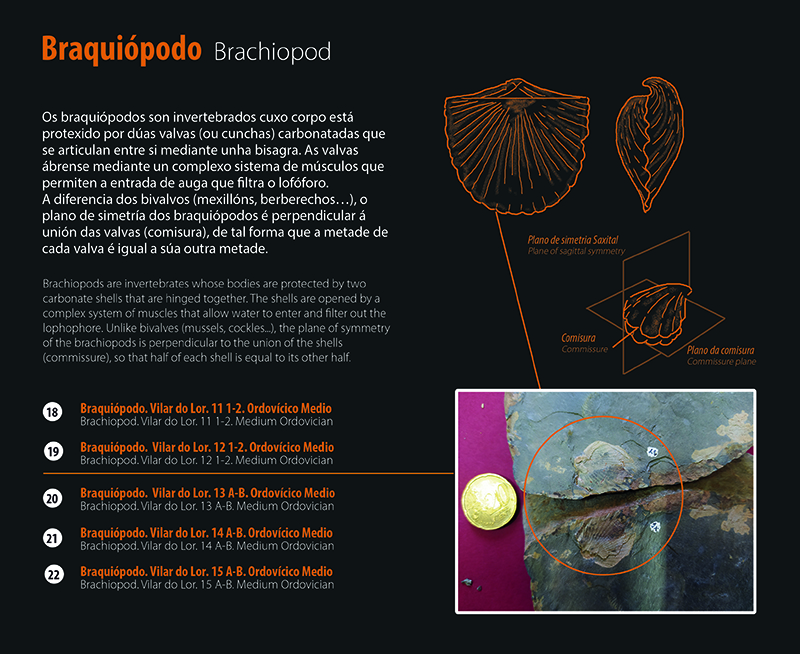
PALEONTOLOGICAL HISTORY OF GALICIA. THE EVOLUTION OF LIFE.
The natural region of Quiroga constitutes, within Galicia, an exceptional environment for the study and observation of the different forms of life from the end of the Precambrian to the present in a time interval that spans more than 650 million years.

*PRECAMBRIAN FOSSILS
The Precambrian is the first and longest period in Earth’s history. It begins when it was formed 4,567.90 – 4,570.10 million years ago and lasts about 4,027 million years.
-STROMATOLITES
Stromatolites appeared about 3,500 million years ago. They help release into the atmosphere the CO2 that transforms a hostile planet into a living environment.
.-EDIACARA INVERTEBRATES
The Ediacara site, discovered in 1946 in Australia, gave its name to the first evidence we have of multicellular organisms with differentiated tissues. They are from about 600 million years ago. Its flat shapes with radial or spiral symmetries are considered a “wrong evolutionary experiment”. Evolution opted mainly for bilateral symmetries. Within the Ediacaran invertebrates are the Charnia masoni, the genus Spriggina and the genus Conomedusa.
.Charnia Masoni
They were animals that lacked a mouth, intestines and anus. It is believed that they extracted their nutrients directly from seawater. For a long time they were thought to be algae. There are now doubts as to whether they were organisms similar to soft corals. They were discovered by a very young hobbyist who would eventually become a renowned geologist.
.Spriggina
His bilaterality was an extravagance for its time. It lived 650 million years ago and resembles a trilobite, so it could be its predecessor.
.Charniodiscus
It was probably a filter that lived anchored to the sandy bottom. It had a structure in the form of a segmented frond that ended in a point. It had a bulb-shaped sticky disk.
*PALEOZOIC FOSSILS
The Paleozoic lasted more than 290 million years. It started 542.0 + – 1.0 million years ago and ended about 251.0 + -0.4 million years ago. It begins shortly after the breakup of the supercontinent Pannotia and ends with the formation of the supercontinent Pangea. It ranges from the proliferation of animals with a shell or exoskeleton to the time when the world began to be dominated by large reptiles.
-CAMBRIAN
The Cambrian is the first of six periods or series of the Paleozoic Era. It started 542.0 + – million years ago and ended about 488.3 + – 1.7 million years ago. Approximately fifty large groups of different organisms arise. This sudden explosion of life is called the “Cambrian explosion.”
.GRAPTOLITES
They were colonial animals that lived in the seas of the Paleozoic, from the Middle Cambrian (570 Ma ago) to the Upper Carboniferous (280 Ma ago). Its name comes from the Greek graptos, which means “written”, and lithos, which means stone ”, since its fossils look like hieroglyphics carved into the rock. Although graptolites are invertebrate fossils, they are now considered to have some remote relationship to vertebrates.
.ARCHEOCIATES
Its name means “old cup”. They were small animals, several centimeters long, conical or cylindrical-conical in shape. They are exclusive to the Lower Cambrian (570-536 million years ago). Together with calcareous algae, they formed marine reefs.
.TRILOBITES
Its name means “three lobes”. They are the most characteristic fossils of the Paleozoic Era. Nearly 4,000 species have been described. They appeared about 540 million years ago. After the late Cambrian mass extinction, only those that inhabited deep water survived. The last ones disappeared about 250 million years ago. Very abundant, they are probably the best known fossils. Although they were considered ancestors of crustaceans, today they are believed to be an independent group within arthropods. A very curious thing about these arthropods was the way they moved: they crawled along the bottom of the sea, leaving their mark on the marine sediments that were transformed into rocks that are called “crucians.”.
TRILOBITES CÁMBRICOS
PARADOXIDES
It was relatively abundant across the planet during the Middle Cambrian period, 540 million years ago. It was moderately large (14 cm) and had a semicircular head and relatively large eyes. Here is a minor paradoxides fossil. The latter was one of the largest trilobites.
-ORDOVICIAN
The Ordovician is the second geological period of the Paleozoic era. It started 488.3 + – 1.7 million years ago and ended 443.7 + – 1.5 million years ago. One day was 21 hours long and there were no animals on the mainland due to the lack of oxygen in the atmosphere. There was a large continent called Gondwana, which included Africa, South America, Antarctica, Australia, India, Iberia, and other smaller landmasses. The Pantalasa Ocean covered most of the Northern Hemisphere.
.ORDOVICIAN TRILOBITES
Its shape was generally long and slim, with a well-segmented thorax. Here we show you the fossils of three different species. Neseuretus tristani, Eodalmantina destombesi and Colpocoryphe.
.ORDOVICIAN BIVALVES
The first bivalves also appeared in this period, already very similar to those of today, aquatic animals with two shells and mainly marine. In the image we show you a fossil of Redonia sp.
.ORDOVICIAN GASTEROPODS
Slugs and snails are gastropods. They also appeared in this period. In the image we show you a Sinuites sp.
-SILURIAN AND DEVONIAN
These periods took place between 416.0 + – and 416.0 + – 2.8 million years ago. In the Silurian the level of the oceans was high, which left many marine fossils on all continents.
ORTHIS
They were characteristic brachiopods of these periods. Brachiopods have two valves, but unlike bivalves, they are not the same. Although more than 12,000 fossil species have been described, there are currently only about 300.








*CAVE BEAR URSUS SPELAEUS
Upright it reached three meters in height and weighed more than 440 kg. He was primarily a vegetarian, in contrast to his successor, the brown bear, which is omnivorous and can better adapt to the natural environment.
The reduction of forest areas at the end of the glacial periods decreased the amount of food available, which led to their extinction 27,500 years ago.
In Galicia, the discovery of the fossil remains of Liñares (Pedrafita, Lugo) stands out for the large number of pieces found: skulls, jaws, vertebrae, scapulae, humeri, radii, wrists, pelvis, femurs, tibias and various phalanges. 10 almost complete skulls were found in good condition. These remains would correspond to 8 males and 18 females, mostly adults. Remains of this species have also been found in the Eirós cave (Cancelo-Vilavella, Triacastela), A Ceza (Noceda, Folgoso do Courel) and in the Cova de Arcoia (Visuña, Folgoso do Courel), the only cave in Galicia where they appear together remains of cave bears and brown bear.
*BROWN BEAR URSUS ARCTOS
It originated in Asia 2,000,000 years ago, reaching Europe in more recent times, 250,000 years ago. He meets and lives with the cave bear. Smaller, its weight is around 250 kg and it has a height at the withers of up to 1.30 m.
In this area remains of brown bears appear in the caves of Tara (Visuña, Folgoso do Courel), Tarelo (Parada de Moreda, Folgoso do Courel), Purruñal (Liñares, Pedrafita do Cebreiro), Sima Paleira and Cova da Arcoira (Visuña , Folgoso do Courel).

QUATERNARY WILDLIFE.
Almost three million years ago, a series of glacial and interglacial cycles began that had a great influence on the climate and sea level. In the ice ages, large tracts of land were covered by an immense layer of ice, while in interglacial times the climate became warmer. Wildlife has been forced to migrate across the continent based on these periods.
Sedimentary rocks do not predominate in Galicia. In addition, its weathering produces acidic sediments that dissolve the calcareous remains, preventing their conservation. All this makes it difficult for fossil remains to appear; however, we can find in some areas favorable conditions for a good fossilization. For example, karstic areas such as O Courel and its surroundings.
*STEPPE BISON BISON PRISCUS
It was similar to the current European bison, but larger and with longer crescent horns. It appeared 580,000 years ago and became extinct at the end of the Pleistocene. At the end of the Paleolithic it became a coveted prey, which is reflected in the many cave paintings of the time. Fossil remains have been found in the Cova de Praducelos (Suegos, Pol, Lugo), in Liñares (Pedrafita do Cebreiro) and in the Cova de Eirós (Cancelo-Vilavella, Triacastela).
*URO BOS TAURUS PRIMIGENIUS
It was bigger and more robust than current bulls, with a height of up to 2 m. It adapted to different ecosystems, from forests to plains. About 700-800 thousand years ago it already lived on the Iberian Peninsula. The last known specimen died in Poland in 1627. In O Courel (Lugo) fossil remains have been found about 8,000 years ago, corresponding to three specimens. Their domestication has given rise to most of our cattle
*CAVE HYENA CROCUTA CROCUTA SPELAEA
It first appeared in Europe about 500,000 years ago. He weighed about 102 kg. He preferred open spaces. It became extinct about 10,000 years ago. Remains were found in A Valiña (Castroverde, Lugo).
*DEER CERVUS ELAPHUS
The first deer fossils date from 25 million years ago, in the Oligocene. Our current deer have had significant size variations over time. The first fossils found correspond to Cervus elaphus acoronatus, characterized by horns topped with a “crown”. The largest deposit was found in Liñares: 739 pieces. Fossil remains of this animal have also been found in the Eirós Cave (Cuncelo-Vilavella, Triacastela).
*ROE DEER CAPREOLUS CAPREOLUS
The ancestors of the current roe deer were larger. In Europe we have fossils from at least 60,000 years ago. Fossil remains associated with the Pleistocene have been found in A Valiña (Castroverde, Lugo) and Liñares (Pedrafita, Lugo).
*WILD BOAR SUS SCROFA
The oldest fossils, found in Asia, are from the Oligocene. It reaches Europe in the Miocene. It had great diversity in the Tertiary. Those of the Pleistocene were larger than the current ones. Fossil remains have been found in A Valiña (Castroverde, Lugo) and Liñares.
*WOOLLY MAMMOTH MAMMUTHUS PRIMIGENIUS ELEPHAS PRIMIGENIUS
It was perfectly adapted to the low temperatures of its time: it had woolly hair up to 90 cm long, a thick layer of insulating fat, and a reduction in the ears. Its size was similar to that of the current elephant. Fossil remains have been found in Buxán (Oural, Lugo). The oldest remains date from 150,000 years ago. It disappeared from Europe 100,000 years ago and from the northern Russian islands a little over 4,000 years ago.

*WOOLLY RHINO COELODONTA ANTIQUITATIS
It inhabited the cold steppes that covered much of Europe and Asia during the Pleistocene. It reached two meters in height and four meters in length. His woolly hair was an adaptation to the low temperatures. Its horns, long and flattened, served as defense and to separate the snow to access the grass. Fossil remains have been found in the Cova de Eirós (Triacastela, Lugo).
